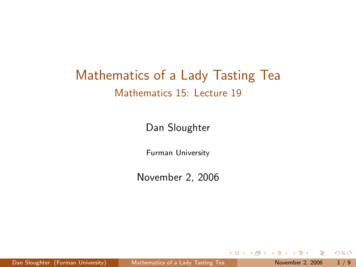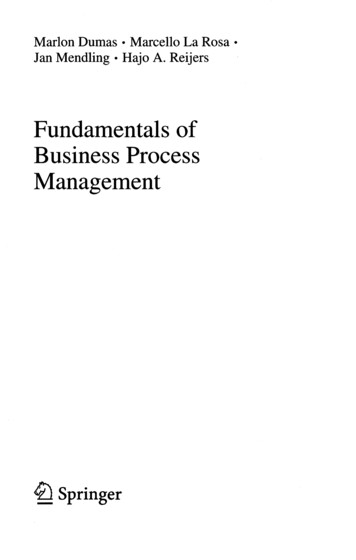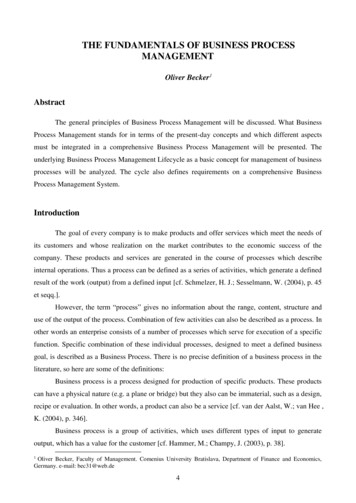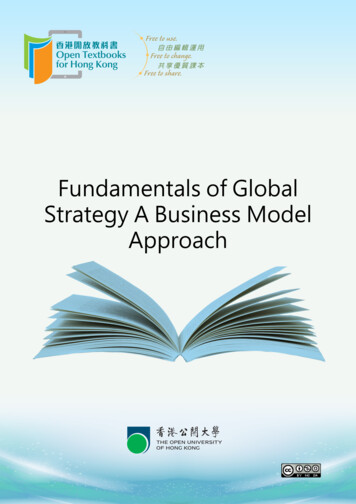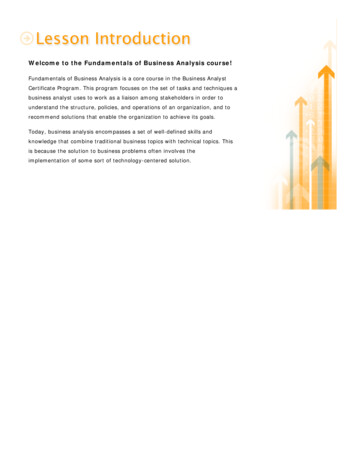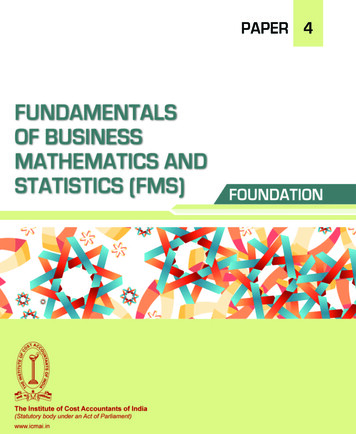
Transcription
FOUNDATION : PAPER -FUNDAMENTALSOF BUSINESSMATHEMATICS ANDSTATISTICSSTUDY NOTESThe Institute of Cost Accountants of IndiaCMA Bhawan, 12, Sudder Street, Kolkata - 700 0164FOUNDATION
First Edition : January 2013Second Edition : September 2014Published by :Directorate of StudiesThe Institute of Cost Accountants of India (ICAI)CMA Bhawan, 12, Sudder Street, Kolkata - 700 016www.icmai.inPrinted at :Repro India LimitedPlot No. 02, T.T.C. MIDC Industrial Area,Mahape, Navi Mumbai 400 709, India.Website : www.reproindialtd.comCopyright of these Study Notes is reserved by the Institute of CostAccountants of India and prior permission from the Institute is necessaryfor reproduction of the whole or any part thereof.
SyllabusPAPER 4: FUNDAMENTALS OF BUSINESS MATHEMATICS AND STATISTICS (FBMS)Syllabus StructureABFundamentals of Business MathematicsFundamentals of Business Statistics40%60%A40%B60%ASSESSMENT STRATEGYThere will be written examination paper of three hours.OBJECTIVESTo gain understanding on the fundamental concepts of mathematics and statistics and its application in business decisionmakingLearning AimsThe syllabus aims to test the student’s ability to: Understand the basic concepts of basic mathematics and statistics Identify reasonableness in the calculation Apply the basic concepts as an effective quantitative tool Explain and apply mathematical techniques Demonstrate to explain the relevance and use of statistical tools for analysis and forecasting Skill sets requiredLevel A: Requiring the skill levels of knowledge and comprehensionCONTENTSSection A: Fundamentals of Business Mathematics1. Arithmetic2. Algebra3. CalculusSection B: Fundamentals of Business Statistics4. Statistical representation of Data5. Measures of Central Tendency and Dispersion6. Correlation and Regression7. Index Numbers8. Time Series Analysis- basic applications including Moving Average9. Probability10. Theoretical DistributionSECTION A: FUNDAMENTALS OF BUSINESS MATHEMATICS [40 MARKS]1.Arithmetic(a)Ratios and Proportions(b) Simple and Compound interest including application of Annuity2.(c)Bill Discounting and Average Due Date(d)Mathematical reasoning – basic applicationAlgebra(a) Set Theory and simple application of Venn Diagram(b)Variation, Indices, Logarithms(c)Permutation and Combinations – basic concepts40%60%
(d)Linear Simultaneous Equations ( 3 variables only)(e)Quadratic Equations(f) Solution of Linear inequalities (by geometric method only)(g)3.Determinants and MatricesCalculus(a) Constant and variables, Functions, Limit & Continuity(b) Differentiability & Differentiation, Partial Differentiation(c) Derivatives – First order and Second order Derivatives(d) Maxima & Minima – without constraints and with constraints using Lagrange transform(e) Indefinite Integrals: as primitives, integration by substitution, integration by part(f) Definite Integrals: evaluation of standard integrals, area under curveSECTION B: FUNDAMENTALS OF BUSINESS STATISTICS [60 MARKS]4.Statistical Representation of Data(a)Diagrammatic representation of data(b)Frequency distribution(c) Graphical representation of Frequency Distribution – Histogram, Frequency Polygon, Ogive, Pie-chart5.Measures of Central Tendency and Dispersion6.(a)Mean, Median, Mode, Mean Deviation(b)Quartiles and Quartile Deviation(c)Standard Deviation(d) Co-efficient of Variation, Coefficient of Quartile DeviationCorrelation and Regression7.(a)Scatter diagram(b)Karl Pearson’s Coefficient of Correlation(c)Rank Correlation(d) Regression lines, Regression equations, Regression coefficientsIndex Numbers(a)Uses of Index Numbers(b) Problems involved in construction of Index Numbers(c)Methods of construction of Index Numbers8. Time Series Analysis – basic application including Moving Average9.(a)Moving Average Method(b)Method of Least SquaresProbability(a) Independent and dependent events; Mutually exclusive events(b) Total and Compound Probability; Baye’s theorem; Mathematical Expectation10.Theoretical Distribution(a) Binomial Distribution, Poisson Distribution – basic application(b)Normal Distribution – basic application4 I FUNDAMENTALS OF LAWS AND ETHICS
ContentSECTION - ABUSINESS MATHEMATICSStudy Note 1 : Arithmetic1.1Ratio & Proportion1.11.2Simple & Compound Interest (Including Application of Annuity)1.61.3Discounting of Bills and Average Due Date1.191.4Mathematical Reasoning - Basic Application1.37Study Note 2 : Algebra2.1Set rithm2.232.5Laws of Indices2.332.6Permutation & Combination2.392.7Simultaneous Linear Equations2.512.8Matrices & Determinants2.56Study Note 3 : 3.4Derivative3.233.5Integration3.57SECTION - BSTATISTICSStudy Note 4 : Statistical Representation of Data4.1Diagramatic Representation of Data4.14.2Frequency Distribution4.54.3Graphical Representation of Frequency Distribution4.10
Study Note 5 : Measures Of Central Tendency and Measures of Dispersion5.1Measures of Central Tendency or Average5.15.2Quartile Deviation5.425.3Measures of Dispersion5.445.4Coefficient Quartile & Coefficient variation5.61Study Note 6 : Correlation and Regression6.1Correlation & Co-efficient6.2Regression Analysis6.16.20Study Note 7 : Index Numbers7.1Uses of Index Numbers7.17.2Problems involved in construction of Index Numbers7.27.3Methods of construction of Index Numbers7.27.4Quantity Index Numbers7.127.5Value Index Number7.137.6Consumber Price Index7.137.7Aggregate Expenditure Method7.147.8Test of Adequacy of the Index Number Formulae7.157.9Chain Index Numbers7.197.10Steps in Construction of Chain Index7.20Study Note 8 : Time Series Analysis8.1Definition8.18.2Components of Time Series8.18.3Models of Time Series Analysis8.28.4Measurement of Secular Trend8.38.5Method of Semi Averages8.38.6Moving Average Method8.38.7Method of Least Squares8.6
Study Note 9 : Probability9.1General Concept9.19.2Some Useful Terms9.19.3Measurement of Probability9.39.4Theorems of Probability9.89.5Bayes’ Theorem9.119.6Odds9.15Study Note 10 : Theoretical Distribution10.1Theoretical Distribution10.110.2Binomial Distribution10.110.3Poisson Distribution10.1310.4Normal Distribution10.19
Section - ABUSINESS MATHEMATICS
Study Note - 1ARITHMETICThis Study Note includes1.1 Ratio & Proportion1.2 Simple & Compound Interest (Including Application of Annuity)1.3 Discounting of Bills & Average Due Date1.4 Mathematical Reasoning - Basic Application1.1 RATIO AND PROPORTION1.1.1 RatioThe ratio between quantities a and b of same kind is obtained by dividing a by b and is denoted by a : b.Inverse Ratio: For the ratio a : b inverse ratio is b : a.A ratio remains unaltered if its terms are multiplied or divided by the same number.a : b am : bm (multiplied by m)a b:(divided by m 0)m m4 6Thus 2 : 3 2 x 2 : 3 x 2 4 : 6 : 2 : 32 2If a b, the ratio a : b is known as ratio of equality.a:b If a b, then ratio a : b is known as ratio of greater inequality i.e. 7 : 4 And for a b, ratio a : b will be theratio of Lesser inequality i.e. 4 : 7.Solved Examples:Example 1 : Reduce the two quantities in same unit.If a 2kg., b 400gm, then a : b 2000 : 400 20 : 4 5 : 1 (here kg is changed to gm)Example 2 : If a quantity increases by a given ratio, multiply the quantity by the greater ratio.5If price of crude oil increased by 4 : 5, which was 20 per unit of then present price 20 4 25 per unit.Example 3 : If again a quantity decreases by a given ratio, then multiply the quantity by the lesser ratio.3In the above example of the price of oil is decreased by 4 : 3, the present price 20 4 15 per unit.If both increase and decrease of a quantity are present is a problem, then multiply the quantity by greaterratio for increase and lesser ratio for decrease, to obtain the final result.1.1.2 ProportionacAn equation that equates two ratios is a proportion. For instance, if the ratiois equal to the ratio,bdthen the following proportion can be written:ExtremesMeansac bdFUNDAMENTALS OF BUSINESS MATHEMATICS AND STATISTICS I 1.1
ArithmeticThe numbers a and d are the extremes of the proportion. The numbers b and c are the means of theproportion.Properties of proportions1.Cross product property: The product of the extremes equals the product of the means.If2.a c , then ad bc.b dReciprocal property: If two ratios are equal, then their reciprocals are also equal.Ifa cb d , then .b da cFew Terms :1. Continued proportions : The quantities a, b, c, d, e . are said to be in continued proportion of a : b b : c c . Thus 1, 3, 9, 27, 81, . are in continued proportion as 1 : 3 3 : 9 9 : 27 27 : 81 .Say for example : If 2, x and 18 are in continued proportion, find x. Now 2 : x x : 18 or,2x or,x 2 36 or, x 6x 18Observation: If a, b, c are in continued proportion, the b 2 ac, b ac .2. Compound Proportion :compounded.If two ormore ratios are multiplied together then they are known asThus a1 a2 a3 : b1 b2 b3 is a compounded ratios of the ratios a1 : b1 ; a2 : b2 and a3 : b3. This method is alsoknown as compound rule of three.Example 4 : 10 men working 8 hours a day can finish a work in 12 days. In how many days can 12 menworking 5 hours a day finish the same work.?Arrangement :x 12 MenHoursday10812125x8 10 16 days5 12Observation : less working hour means more working days, so multiply by greater ratiomen means less number of days, so multiply by lesser ratio10.12Derived Proportion : Given quantities a, b, c, d are in proportion.(i) Invertendo : If a : b c : d thenb:a d:c(ii) Alternendo : If a : b c : d, then a : c b : d(iii) Componendo and DividendoIfa ca b c d then b da b c d1.2 I FUNDAMENTALS OF BUSINESS MATHEMATICS AND STATISTICS8. Again more5
Proof : LetL. H. S. a c k , then a bk, c dkb dbk b b(k 1) k 1 bk b b(k 1) k 1R. H. S. dk d d(k 1) k 1 . Hence the result, L.H.S. R.H.S. (Proved)dk d d(k 1) k 1Note. 1.x y z is sometimes written as x : y : z a : b : c.a b c2. If x : y a : b, it does not mean x a, y b. It is however to take x ka, y kb.Solved Examples :Example 5 :4x 3z 4z 3y 4y 3xx y z If , show that each ratio is equal to.4c3b2a,2a 3b 4cEach of the given ratio 4x 3z 4z 3y 4y 3xx y z 4c 3b 2a2a 3b 4cExample 6 : The marks obtained by four examinees are as follows :A : B 2 : 3, B : C 4 : 5, C : D 7 : 9, find the continued ratio.A:B 2: 333153B : C 4 : 5 4 :5 3 :[for getting same number in B, we are to multiply by ]4444C:D 7:9 7 1515 1 15 15 135: :[to same term of C, multiply by]28 9 28 4 2828A:B:C:D 2: 3:15 135 56 : 84 : 105 : 135.:428Example 7 : Two numbers are in the ratio of 3 : 5 and if 10 be subtracted from each of them, theremainders are in the ratio of 1 : 5, find the numbers.Let the numbers be x and y, so thatAgainx 3 or,5x 3y.(1)y 5x 10 1 y 10 5or, 5x–y 40 .(ii) , Solving (I) & (ii), x 12, y 20 Required Numbers are 12 and 20.Example 8 : The ratio of annual incomes of A and B is 4 : 3 and their annual expenditure is 3 : 2 . If each ofthem saves 1000 a year, find their annual income.FUNDAMENTALS OF BUSINESS MATHEMATICS AND STATISTICS I 1.3
ArithmeticLet the incomes be 4x and 3x (in )Now4x 1000 3 or, x 1000 (on reduction)3x 1000 2 Income of A 4000, that of B 3000.Example 9 : The prime cost of an article was three times the value of material used. The cost of rawmaterials was increased in the ratio 3 : 4 and the productive wage was increased in the ratio 4 : 5. Find thepresent prime cost of an article, which could formerly be made for 180.Prime cost x y, where x productive wage, y material used.Now prime cost 180 3y or, y 60, again x y 180, x 180–y 180–60 120Present material cost Present prime cost 4y5x, present wage ,344 60 5 120 80 150 230.34SELF EXAMINATION QUESTIONS :1.The ratio of the present age of a father to that of his son is 5 : 3. Ten years hence the ratio would be3 : 2. Find their present ages.[Ans. 50,30]2.The monthly salaries of two persons are in the ratio of 3 : 5. If each receives an increase of 20 insalary, the ratio is altered to 13 : 21. Find the respective salaries.[Ans. 240, 400]3.What must be subtracted from each of the numbers 17, 25, 31, 47 so that the remainders may be inproportion.[Ans. 3]4.In a certain test, the number of successful candidates was three times than that of unsuccessfulcandidates. If there had been 16 fewer candidates and if 6 more would have been unsuccessful, thenumbers would have been as 2 to 1. Find the number of candidates.[Ans. 136]5.(i)Monthly incomes to two persons are in ratio of 4 : 5 and their monthly expenditures are in theratio of 7 : 9. If each saves 50 a month, find their monthly incomes.[Ans. 400, 500](ii)Monthly incomes of Ram and Rahim are in the ratio 5 : 7 and their monthly expenditures arein the ratio 7 : 11. If each of them saves 60 per month. Find their monthly income.[Ans. 200, 280]hint s6.5x 607 & etc.7x 60 11A certain product C is made or two ingredients A and B in the proportion of 2 : 5. The price of A isthree times that of B.The overall cost of C is 5.20 per tonne including labour charges of 80 paise per tonne. Find thecost A and B per tonne.[Ans. 8.40, 2.80]7. The prime cost of an article was three times than the value of materials used. The cost of raw materialsincreases in the ratio of 3 : 7 and productive wages as 4 : 9. Find the present prime cost of an articlewhich could formerly be made for 18.[Ans. 41]1.4 I FUNDAMENTALS OF BUSINESS MATHEMATICS AND STATISTICS
8.There has been increment in the wages of labourers in a factory in the ratio of 22 : 25, but there hasalso been a reduction in the number of labourers in the ratio of 15 : 11. Find out in what ratio the totalwage bill of the factory would be increased or decreased.[Ans. 6 : 5 decrease]9.Three spheres of diameters 2, 3 and 4 cms. respectively formed into a single sphere. Find the diameterof the new sphere assuming that the volume of a sphere is proportional to the cube of its diameter.[Ans. 3 81 cm ]OBJECTIVE QUESTIONS :1.Find the ratio compounded of 3 :7, 21 : 25, 50 : 54[Ans. 1 : 3]2.What number is to be added to each term of the ratio 2 : 5 to make to equal 4 :5.3.Find the value of x when x is a mean proportional between : (i) x–2 and x 6(ii) 2 and 32[Ans. (i) 3 (ii) 8]4.If the mean proportional between x and 2 is 4, find x5.If the two numbers 20 and x 2 are in the ratio of 2 : 3 ; find x6.If7.If 3, x and 27 are in continued proportion, find x8.What number is to be added to each term of the ratio 2 : 5 to make it 3 : 4 ?a ba bHint s :9.If10. If [Ans. 10][Ans. 8][Ans. 28]1afind2b[Ans.9][Ans. 9][Ans. 7]2 x 3 & etc.5 x 4a b 2 find the value ofa ba2 ab b2a2 ab b2[Ans.7]134x 3y 4z 3y 4y 3xx y z show that each ratio is equal to4c3b2a2a 3b 4cHint s : each ratio 4x 3z 4z 3y 4y 3x& etc.4c 3b 2a11. The ratio of the present age of mother to her daughter is 5 : 3. Ten years hence the ratio would be3 : 2. Find their present ages.[Ans. 50; 30 years]12. If A : B 2 : 3, B : C 4 : 5 and A : C[Ans. 8 :15]13. If x : y 3 : 2, find the value of (4x–2y) : (x y)[Ans. 8 : 5]14. If 15 men working 10 days earn 500. How much will 12 men earn working 14 days?15. Fill up the gaps :a a2 1 – b2 b 1 [Ans. ab, b a,a b,b3 a,in order]16. If x, 12, y and 27 are in continued proportion, find the value of x and y17. Ifx 37x 4y , find the value ofy 43x y[Ans. 560][Ans. 8 ; 18][Ans.5]13FUNDAMENTALS OF BUSINESS MATHEMATICS AND STATISTICS I 1.5
Arithmetic18. What number should be subtracted from each of the numbers 17, 25, 31, 47 so that the remainders arein proportion.[Ans. 3]Hint s :17 x 31 x or 325 x 47 x19. 10 years before, the ages of father and son was in the ratio 5 : 2; at present their total age is 90 years.Find the present age of the son.[Ans. 30 years]20. The ratio of work done by (x–1) men in (x 1) days9 : 10 , find the value of x.Hint s:to that of (x 2) men in (x–1) days is(x 1)(x 1)9 & etc.(x 2)(x 1) 10[Ans. 8]1.2 SIMPLE & COMPOUND INTEREST (Including Application of Annuity)1.2.1 Simple InterestThe price to be paid for the use of a certain amount of money (called principal) for a certain period isknown as Interest. The interest is payable yearly, half-yearly, quarterly or monthly.The sum of the principal and interest due at any time, is called the Amount at that time.The rate of interest is the interest charged on one unit of principal for one year and is denoted by i. If theprincipal is 100 then the interest charged for one year is usually called the amount of interest per annum,and is denoted by r ( Pi).e.g. if the principal is 100 and the interest 3, then we say usually that the rate of interest is 3 percent perannum (or r 3 %)Here i 3 0.03(i.e. interest for 1 rupee for one year).100Simple interest is calculated always on the original principal for the total period for which the sum (principal)is used.Let P be the principal (original)n be the number of years for which the principal is usedr be the rate of interest p.a.I be the amount of interesti be the rate of interest per unit (i.e. interest on Re. 1 for one year)]rNow I P.i.n, where i 100Amount A P I P P. i. n P (1 i.n) i.e. A P (1 n .i)Observation. So here we find four unknown A, P, i., n, out of which if any three are known, the fourth onecan be calculated.1.6 I FUNDAMENTALS OF BUSINESS MATHEMATICS AND STATISTICS
SOLVED EXAMPLES :Example 10 : Amit deposited 1200 to a bank at 9% interest p.a. find the total interest that he will get at theend of 3 years.9 0.09, n 3, I ?100I P. i.n 1200 x 0.09 x 3 324.Here P 1200, i Amit will get 324 as interest.Example 11 : Sumit borrowed 7500 at 14.5% p.a. for 21years. Find the amount he had to pay after that2period.P 7500, i 14.51 0.145, n 2 2.5,A ?1002A P (1 in) 7500 (1 0.145 x 2.5) 7500 (1 0.3625) 7500 1.3625 10218.75Reqd. amount 10218.75.Example 12 : Find the simple interest on 5600 at 12% p.a. from July 15 to September 26, 2013.Time number of days from July 15 to Sept. 26 16 (July) 31 (Aug.) 26 (Sept.) 73 days.P 5600, i 12731yr. yr. 0.12, n 1003655S.I. P. i.n. 5600 x 0.12 x1 134.45 Reqd. S.I. 134.40.(In counting days one of two extreme days is to be excluded, Usually the first day is excluded).To find Principle :Example 13 : What sum of money will amount to 1380 in 3 years at 5% p.a. simple interest?Here A 1380, n 3, i 5 0.05,P ?100From A P (1 0.05x3) or, 1380 P (1 0.15)Or, 1380 P (1.15) or, P 1380 12001.15 Reqd. sum 1200Example 14 : What sum of money will yield 1407 as interest in 11year at 14% p.a. simple interest.2Here S.I. 1407, n 1.5, I 0.14, P ?S.I. P. i.n. or, 1407 P x 0.14 x 1.5Or, P 14071407 67000.14 1.5 0.21 Reqd. amount 6700.FUNDAMENTALS OF BUSINESS MATHEMATICS AND STATISTICS I 1.7
ArithmeticExample 15 : What principal will produce 50.50 interest in 2 years at 5% p.a. simple interest.S.I. 50.50, n 2, i 0.05, P ?S.I. P. i.n. or, 50.50 P x 0.05 x 2 P x 0.10or, P 50.50 5050.10 Reqd. principal 505.Problems to find rate % :Example 16 : A sum of 1200 was lent out for 2 years at S. I. The lender got 1536 in all. Find the rate of interestp.a.P 1200, A 1536, n 2, i ?A P (1 ni) or 1536 1200 (1 2i) 1200 2400 ior, 2400i 1536 – 1200 336 or, i 336 0.142400 Reqd. rate 0.14 x 100 14%.Example 17 : At what rate percent will a sum, become double of itself in 5A 2P, P Principal, n 51,i ?2A P (1 ni) or, 2P P (1 11i)2or, 2 1 or,1years at simple interest?2112i or, i 211n 2 100 18.18 (approx);11Reqd. rate 18.18%.Problems to find time :Example 18 : In how many years will a sum be double of itself at 10% p.a. simple interest.A 2P, P Principal, i 10 0.10, n ?100A P (1 ni) or, 2P P [1 n(.10)] or, 2 1 n (.10)or, n (.10) 1or, n 1 10.10 Reqd. time 10 years.Example 19 : In what time 5000 will yield 1100 @ 5P 5000, S.I. 1100, i 1%?25 21 0.055, n ?100S.I. P. ni or, 1100 5000 n (0.055) 275 nor,n 1100 4.275 Reqd. time 4 years.1.8 I FUNDAMENTALS OF BUSINESS MATHEMATICS AND STATISTICS
Example 20 : In a certain time 1200 becomes 1560 at 10% p.a. simple interest. Find the principal thatwill become 2232 at 8% p.a. in the same time.In 1st case : P 1200, A 1560, i 0.10, n ?1560 1200 [1 n (.10)] 1200 120 nor, 120 n 360or, n 3In 2nd case : A 2232, n 3, i 0.08, P ?2232 P (1 3 0.08) P (1 0.24) 1.24 Por,P 2232 1800.1.24Example 21 : A person borrowed 8,000 at a certain rate of interest for 2 years and then 10,000 at 1%lower than the first. In all he paid 2500 as interest in 3 years. Find the two rates at which he borrowed theamount.Let the rate8000 or,ofinterest r, so that in the2ndcase, rate of interest will be (r–1). Nowr(r 1) 2 10,000 1 2500100100160r 100 r – 100 2500 or, r 10stIn 1 case rate of interest 10% and in 2nd case rate of interest (10 – 1) 9%Calculations of interest on deposits in a bank : Banks allow interest at a fixed rate on deposits from a fixedday of each month up to last day of the month. Again interest may also be calculated by days.SELF EXAMINATION QUESTIONS1.2.What sum will amount to 5,200 in 6 years at the same rate of simple interest at which 1,706 amount to 3,412 in 20 years?[Ans. 4000]2The simple interest on a sum of money at the end of 8 years is th of the sum itself. Find the rate5percent p.a.[Ans. 5%]3.A sum of money becomes double in 20 years at simple interest. In how many years will it be triple?[Ans. 40 yrs.]4.At what simple interest rate percent per annum a sum of money will be double of it self in 25 years?[Ans. 4%]5.A certain sum of money at simple interest amounts to 560 in 3 years and to 600 in 5 years. Find theprincipal and the rate of interest.[Ans. 500; 4%]6.A tradesman marks his goods with two prices, one for ready money and the other for 6 month’s credit.What ratio should two prices bear to each other, allowing 5% simple interest.[Ans. 40 : 41]7.1% simple interest p.a. respectively. At the2end of 6 years, he receives 462 from them. How much did he lend to each other?[Ans. 800; 1000]A man lends 1800 to two persons at the rate of 4% and 4FUNDAMENTALS OF BUSINESS MATHEMATICS AND STATISTICS I 1.9
Arithmetic8.A man takes a loan of 10,000 at the rate of 6% S.I. with the understanding that it will be repaid withinterest in 20 equal annual instalments, at the end of every year. How much he is to pay in eachinstalment?[Ans. 700.64][Hints. 10,000 (1 20 .06) P (1 19 .06) P(1 18 .06) P]9.The price of a watch is 500 cash or it may be paid for by 5 equal monthly instalments of 110 each,the first instalment to be paid one month after purchase. Find the rate of interest charged.[Ans. 426%]710. Divide 12,000 in two parts so that the interest on one part at 12.5% for 4 years is equal to the intereston the second part at 10% for 3 years.[Ans. 4500; 7500]11. Alok borrowed 7500 at a certain rate for 2 years and 6000 at 1% higher rate than the first for 1 year.For the period he paid 2580 as interest in all. Find the two of interest.[Ans. 12%; 13%]12. If the simple interest on 1800 exceeds the interest on 1650 in 3 years by 45, find the rate of interestp.a.[Ans. 10%]Objective Question1.At what rate of S.I. will 1000 amount to 1200 in 2 years?2.In what time will 2000 amount to 2600 at 5% S.I.?3.At what rate per percent will S.I. on 956 amount to 119.50 in 24.To repay a sum of money borrowed 5 months earlier a man agreed to pay 529.75. Find the amountborrowed it the rate of interest charged was 4[Ans. 10%][Ans. 6 yrs.]1years?21% p.a.2[Ans. 5%][Ans. 520]5.What sum of money will amount to 5200 in 6 years at the same rate of interest (simple) at which 1706 amount to 3412 in 20 years?[Ans. 4000]6.A sum money becomes double in 20 years at S.I., in how money years will it be triple?[Ans. 40 years]7.A certain sum of money at S.I. amount to 560 in 3 years and to 600 in 5 years. Find the principal andthe rate of interest.[ Ans. 500; 4%]8.In what time will be the S.I. on 900 at 6% be equal to S.I. on 540 for 8 years at 5%.9.Due to fall in rate of interest from 12% to 10Find the capital.[Ans. 4 years]1% p.a.; a money lender’s yearly income diminishes by 90.2[Ans. 6000]10. A sum was put at S.I. at a certain rate for 2 years. Had it been put at 2% higher rate, it would havefetched 100 more. Find the sum.[Ans. 10,000]11. Complete the S. I. on 5700 for 2 years at 2.5% p.a.[Ans. 285]12. What principal will be increased to 4600 after 3 years at the rate of 5% p.a. simple interest?[Ans. 4000]13. At what rate per annum will a sum of money double itself in 10 years with simple interest ?[Ans. 10%]1.10 I FUNDAMENTALS OF BUSINESS MATHEMATICS AND STATISTICS
15. The simple interest on 300 at the rate of 4% p.a. with that on 500 at the rate of 3% p.a. both for thesame period, is 162. Find the time period.[Ans. 6 years]16. Calculate the interest on 10,000 for 10 years at 10% p.a.[Ans. 10,000]1.2.2 COMPOUND INTERESTInterest as soon as it is due after a certain period, is added to the principal and the interest for the succeedingperiod is based upon the principal and interest added together. Hence the principal does not remainsame, but increases at the end of each interest period.A year is generally taken as the interest-period, but in most cases it may be half-year or quarter-year.Note. Compound interest is calculated by deducting the principal from the amount (principal interest) atthe end of the given period.Simple Interest for 3 years on an amount was 3000 and compound interest on the same amount at thesame rate of interest for 2 years was 2, 100. Find the principal and the rate in interest.Let the amount be x and rate of interest x i. Now x. i. 3. 3000 (i)Again x (1 i)2 – x 2100, from C.I P (1 i)2 – P, P Principalor, xi (2 i) 2100or, 1000 (2 i) 2100, by (i)or, (2 i) 2.1 or, i 2.1 – 2 0.1 10%From x. (0. 1) . 3 3000 or, x 10,000 Required principal is 10,000 and rate of interest is 10%Using Logarithm :In calculating compound interest for a large number of years, arithmetical calculation becomes too bigand out of control. Hence by applying logarithm to the formula of compound interest, the solution becomeseasy.Symbols :Let P be the Principal (original)A be the amounti be the Interest on Re. 1 for 1 yearn be the Number of years (interest period).Formula : A P(1 i)n . (i)Cor.1. In formula (i) since P amount to A in years, P may be said to be present value of the sum A due in nyears.P An(1 i) A (1 i ) nCor.2. Formula (1) may be written as follows by using logarithm :log A log P n log (1 i)Note. If any three of the four unknowns A, P, n and i are given, we can find the fourth unknown from theabove formula.FUNDAMENTALS OF BUSINESS MATHEMATICS AND STATISTICS I 1.11
ArithmeticFEW FORMULAE :Compound Interest may be paid half-yearly, quarterly, monthly instead of a year. In these cases differencein formulae are shown below :(Taken P principal, A amount, T total interest, i interest on Re. 1 for 1 year, n number of years.)Time(i)(ii)AnnualAmountI A–PA P(1 I)nI P {(1 i)n –1}2niA P 1 2Half-YearlyiA P 1 4(iii) QuarterlyiIn general if C.I. is paid p times in a year, then A P 1 pi2I P1 I Pi1 44n2n 14n 1pn.i.e. : Let P 1000, r 5% i.e., i 0.05, n 24 yrs.If interest is payable yearly the A 1000 (1 0.5)24If int. is payable half-yearly the A 1000 1 0.052If int. is payable quarterly then A 1000 1 0.0542 244 24Note. or r 100 I interest per hundred.If r 6% then If, however i 0.02 then, r 100 0.02 2%.SOLVED EXAMPLES. (using log tables)[To find C.I.]Example 22 : Find the compound interest on 1,000 for 4 years at 5% p.a.Here P 1000, n 4, i 0.05, A ?We have A P (1 i)nA 1000 (1 0.05)4Or log A log 1000 4log (1 0.05) 3 4 log (1. 05) 3 4 (0.0212) 3 0.0848 3.0848A antilog 3.0848 1215C.I. 1215 – 1000 215[To find time]Example 23 : In what time will a sum of money double itself at 5% p.a. C.I.Here, P P, A 2P, i 0.05, n ?1.12 I FUNDAMENTALS OF BUSINESS MATHEMATICS AND STATISTICS
A P (1 i)n or, 2P P(1 0.05)n P (1.05)nor, 2 (1.05)n or log 2 n log 1.05 n log 20.3010 14.2 years (Approx)log 1.05 0.0212 (anti-logarithm table is not required for finding time).[To find sum]Example 24 : The difference between simple and compound interest on a sum put out for 5 years at 3%was 46.80. Find the sum.Let P 100, i .03, n 5. From A P (1 i)n,A 100 (1 .03)5 100 (1.03)5log A log 100 5 log (1.03) 2 5 (.0128) 2 .0640 2.0640 A antilog 2.0640 115.9 C.I. 115.9 – 100 15.9Again S.I. 3 5 15. difference 15.9 – 15 0.9Diff.Capital0.910 046.80xx 100 46.80 5,2000.9 original sum 5,200.[ To find present value]Example 25 : What is the present value of 1,000 due in 2 years at 5% compound interest, according as theinterest is paid (a) yearly, (b) half-yearly ?(a) Here A 1,000, i 5 0.05, n 2, P ?100A P (1 i)n or 1000 P (1 .05)2 P(1.05)2 P 1000(1.05)2 1000 907.031.1025 Present value 907.03(b) Interest per unit per half-yearFrom A P 1 1,000 P 1 i20.0521 0.05 0.02522nwe find.2 2 P (1 .025)4 P (1.025)4FUNDAMENTALS OF BUSINESS MATHEMATICS AND STATISTICS I 1.13
Arithmeticor,P 10004(1.025) log P log 1000 – 4log (1.025) 3 – 4 (0.0107) 3 – 0.0428 2.9572 P antilog 2.9572 906.1.Hence the present amount 906.10[To find rate of interest]Example 26 : A sum of mo
FOUNDATION STUDY NOTES FOUNDATION : PAPER - 4 FUNDAMENTALS OF BUSINESS MATHEMATICS AND STATISTICS The Institute of Cost Accountants

